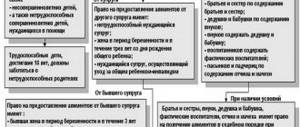5
Alimony obligations serve to provide support to citizens who are not able to independently acquire everything necessary for their life. These are mainly minor children, but the law also provides for alimony for disabled parents, spouses, and some other persons.
Payers of alimony are obliged to fulfill their obligation within the established time limits, but in some cases they do not pay the assistance voluntarily. In such situations, recipients have the right to use the mechanisms provided for the collection of payments for the past period.
Is it possible to recover alimony for previous years?
At what point does a parent have the obligation to provide financially for a minor child?
If we look for the answer to this question in the broadest, moral sense, then we can say that from the very birth of the child. If parents and children live together as a family, the default is that this duty is satisfied. If the parents divorce and move away, the one with whom the child remains to live has the right to demand monetary payments from the other for the maintenance of the child. Sometimes a requirement for alimony payment is made without a divorce - regardless of whether the parents are married or not, the responsibility to support the children lies with them equally.
If, in a narrow, procedural sense, we look for the answer to the question from what moment a parent is obligated to pay child support, then the answer will be - from the moment the corresponding demands are presented by the second parent. The requirement must be in the form of a document -
- a statement of claim filed in court;
- a signed and notarized alimony agreement.
As a general rule, the calculation of alimony begins from the moment a claim is filed with a court. Regardless of how long the court process will be (and it can be quite lengthy, for example, if a demand for child support is made simultaneously with a demand for divorce and determination of the children’s place of residence), the calculation of alimony does not begin from the moment the court decision is made, namely from the moment the claim is filed. It is important.
But in this case the question often arises. If the responsibility to support the child always lies with the parent, regardless of registration or divorce, then why can you receive alimony only from the moment the claim is filed? Why can't we get the full amount that hasn't been paid for months or years?
Expert opinion
Semyon Frolov
Lawyer. 7 years of experience. Specialization: family, inheritance, housing law.
For example, after the divorce, the mother remained to live with two young children. The father moved to another city and did not maintain contact with the family. The mother provided for the children on her own for 7 years, while the father did not even remember about them. When her mother became seriously ill and lost her job, she decided to go to court for child support. In her statement of claim, she filed a demand for the collection of alimony for the previous 7 years, during which she supported the children herself without the help of her father.
It is clear that the absence of legal demands from the mother for 7 years in no way relieved the father of his obligations to his two children. He was obliged to support them regardless of whether the mother sued for child support or not. But can the court now satisfy the demand for the recovery of sums of money that have not been paid for such a long time? No.
So, as a general rule, alimony payments begin to accrue from the moment you go to court. But the law provides, as an exception, for the possibility of collecting alimony for the past time . It is clear that this possibility poses a risk of speculation and abuse on the part of some parents. Therefore, for its implementation, the law establishes strict conditions and limited periods.
Below we will consider both the conditions for receiving alimony for the past and the periods during which it is possible to receive unpaid alimony.
For what period can alimony be collected?
By virtue of paragraph 2 of Article 107 of the Family Code, alimony can only be collected for the past 3 years before the filing of the claim in court.
In this case, the conditions must be met - before going to court, the parent took independent and persistent measures to obtain assistance for the maintenance of the children (which, of course, must be proven in court), but these measures did not bring results - the parent avoided providing financial support.
If a claim has already been filed before, for which there is a court decision on the payment of alimony, the situation is completely different. You can recover the unpaid amount not for three years, but for the entire period - from the moment of the initial application to the court.
Let's remember the example above again. If the mother of two children had applied to the court for alimony immediately after the divorce and received a positive court decision, the situation would have been completely different. No statute of limitations would apply in this case. Failure by the father to pay alimony for 7 years would lead to the accumulation of a debt, which he would be obliged to repay in full, with all penalties and, which is possible, even with administrative or criminal liability measures. But, since the mother did not apply for alimony, at best, she will be able to obtain payments for the previous three years, at worst, she will be content with payments in the future.
Package of documents
When submitting an application, you must attach documents that serve as evidence of the plaintiff’s position:
- Documents on the identities of the plaintiff and defendant (if available).
- Marriage or divorce certificates.
- Birth certificates of children.
- Certificates of income of the parties.
- Health papers.
- Documents about attempts to resolve the conflict voluntarily (demand with a person’s signature confirming delivery or postal documents confirming dispatch).
- Papers confirming the plaintiff’s expenses (for example, invoices for the purchase of medications).
- Motions to call witnesses.
- Power of attorney, if the application is submitted by a representative.
When filing a claim, you must attach copies, and bring the originals to the hearing for certification. When submitting an order, originals or notarized copies must be attached.
Conditions for collecting alimony for the past period
It is Article 107 of the Family Code that establishes that alimony for the previous three years can be collected only if the recipient took measures to receive alimony, but the payer evaded paying it.
Conditions for collecting alimony for the previous three years:
- There was no alimony agreement between the parents;
- Child support was not paid voluntarily by the father;
- Measures taken by the mother to collect child support remained ineffective;
- The mother goes to court with a request to collect alimony for the past time;
- Alimony is collected no more than for the last 3 years.
Let's look at the example above. If the mother had not remained silent for 7 years, but had periodically reminded the father of his parental responsibilities and tried to achieve voluntary payment - in the form of telephone calls, letters, conversations in the presence of witnesses asking for help in supporting the children, she would have been able to demand payment of alimony for the previous three years. Of course, not in seven years, but only in three years, which is also quite good.
How to collect alimony for the last three years
If no alimony agreement has been concluded, you can file for alimony in court. Although, as a general rule, alimony is calculated from the date of application to the court, as an exception, you can ask for alimony to be calculated for the three years preceding this day . The law does not provide for the collection of alimony for a longer period.
According to the conditions listed above, it is necessary to provide the court with evidence that over the past three years attempts have been made to obtain alimony, but they did not bring the expected result - it was not possible to achieve alimony payments.
Statement of claim, documents, evidence
The beginning of the process of collecting alimony is a statement of claim, which should contain not only a demand for the collection of alimony for the past 3 years, but also a detailed statement of the circumstances and significant evidence that substantiates this demand.
In addition to the basic information that the statement of claim must contain, the following circumstances should be detailed and evidence provided:
- The plaintiff tried to obtain financial assistance. Such evidence may be correspondence (both “paper” and electronic), recordings of conversations, testimony (for example, if a witness was present during a conversation or heard a conversation on the phone with the speakerphone on);
- The defendant did not provide financial assistance to the child and evaded fulfilling his parental responsibilities. The following may serve as evidence:
- statements of bank accounts of the plaintiff, where there are no receipts of funds from the defendant;
- documents confirming the amount of expenses of the plaintiff (receipts for payment for kindergarten services, clubs and sections, receipts for purchases of food, clothing, toys, office supplies);
- documents on the defendant’s income;
- documents confirming the absence of the defendant at the place of registration;
- other documents.
The list of documents that can serve as evidence of the defendant’s evasion of financial assistance depends on the circumstances.
Expert opinion
Dmitry Nosikov
Lawyer. Specialization: family and housing law.
Helpful advice. A high-quality evidence base is the key to a successful outcome of the case. Therefore, the preparation of documents that will serve as significant evidence of the parent’s failure to fulfill his obligations should be taken seriously. There is no need to rush into legal proceedings, because collecting checks and receipts, regularly sending letters and receiving (or not receiving!) responses, video recording meetings or dictating conversations takes time. It is better to spend six months preparing the evidence base and receive alimony for the past three years than to rush to go to court without proper evidence and be content with alimony for the future.
However, you shouldn’t delay going to court too long. After all, the judge will ask the inevitable question - why didn’t the plaintiff apply for judicial protection of the rights of the child earlier?
In addition to the listed evidence, the claim must be accompanied by a standard package of documents, including...
- child's birth certificate;
- a copy of the plaintiff’s passport, a copy of the defendant’s passport - if available;
- marriage certificate or divorce certificate;
- certificate of family composition;
- certificate from the place of work about the amount of earnings;
- other documents.
Judicial review
Having studied the circumstances, listened to the requirements and considered the evidence provided, the court may decide to oblige the payer to pay alimony not only in the future, but also for the past time (no more than for the last three years).
Calculation of debt for the past 3 years
First of all, the court determines the amount of alimony for the future. As you know, they can have the shape...
- shares of earnings;
- a fixed amount of money.
In addition to the amount and procedure for paying alimony for the future, the court decision contains the duration of the past period for which alimony must be paid (up to 3 years). Based on this data, the amount of debt will be calculated.
If alimony is assigned in shared form, data on the defendant’s place of work and the amount of earnings over the past period will be used to calculate the amount of the debt. If during this period the defendant did not have official earnings (or did not provide certificates about its amount), alimony will be calculated according to the average salary in the Russian Federation.
If alimony is assigned in a fixed amount, the amount of the debt is calculated and indexed based on the cost of living established in the region of residence.
You can learn more about the rules and procedure for calculating alimony arrears in the article “How to calculate alimony arrears.” You can also read the article “How to find out your alimony arrears.”
If the plaintiff or defendant does not agree with the calculation of the amount of alimony debt, he has the right to challenge it in court - by appealing to a higher court.
Collection of alimony
Based on the court decision, a writ of execution will be issued, which will indicate the amount of monthly alimony payments and the amount of debt over the past period.
Payment agreement
If an agreement on payment of alimony was signed and duly certified between the parties, then collection for the past 3 years is not possible. The agreement already contains the amount of the penalty and other conditions, and in case of non-fulfillment, the recipient can directly contact the bailiff service.
If the terms of the agreement do not suit one of the parties, then it has the right to appeal it in court. However, such an appeal is impossible without significant reasons (for example, the party was misled or threatened).
How do court proceedings in alimony disputes proceed? The answer is presented in the article “How the child support court proceeds.” You can find out what the Resolution of the Plenum of the Supreme Court of the Russian Federation on alimony contains here.
Arbitrage practice
There is a legal provision for the collection of alimony for the past period. But how alive and effective is it? Judicial practice shows that it is very difficult to realize the right provided by law.
Expert opinion
Semyon Frolov
Lawyer. 7 years of experience. Specialization: family, inheritance, housing law.
First, it is necessary to provide the court with evidence that the mother made desperate but unsuccessful attempts to get at least some money from the father. You can count on success only in the targeted and advance preparation of the evidence base.
Secondly, it is difficult to collect significant evidence that during this time the father did not pay a penny (usually the father receives at least some kind of financial assistance, which is taken into account by the court).
Thirdly, it is difficult to explain why all this time the mother did not apply for child support to the court.
Fourthly, demanding to collect alimony from the father for the past three years (and this is a considerable amount), mothers find it difficult to explain to the court why they need this money. It is good if there is documentary evidence of significant expenses for the child over the past three years (treatment, rehabilitation, education). If not, it will be difficult to prove the need to collect such large sums of money.
As a result, in most cases the court refuses to collect alimony for the previous period. Cases when it is possible to achieve money over the past three years are extremely rare. As a rule, alimony payments begin to arrive only after going to court.
Duration of the proceedings and results
Legal proceedings for the collection of alimony must be completed within a period not exceeding one month from the date of filing the application with the court. Within this period, the application must be accepted, considered and an appropriate decision made.
The outcome of the trial directly depends on the evidence provided by the parties. The plaintiff must prove that he made attempts to voluntarily fulfill his obligations, but the defendant still did not fulfill them.
The defendant proves either the fact of fulfillment of his obligations, or demands a reduction in the amount of payments. The defendant also has the right to accept claims.








